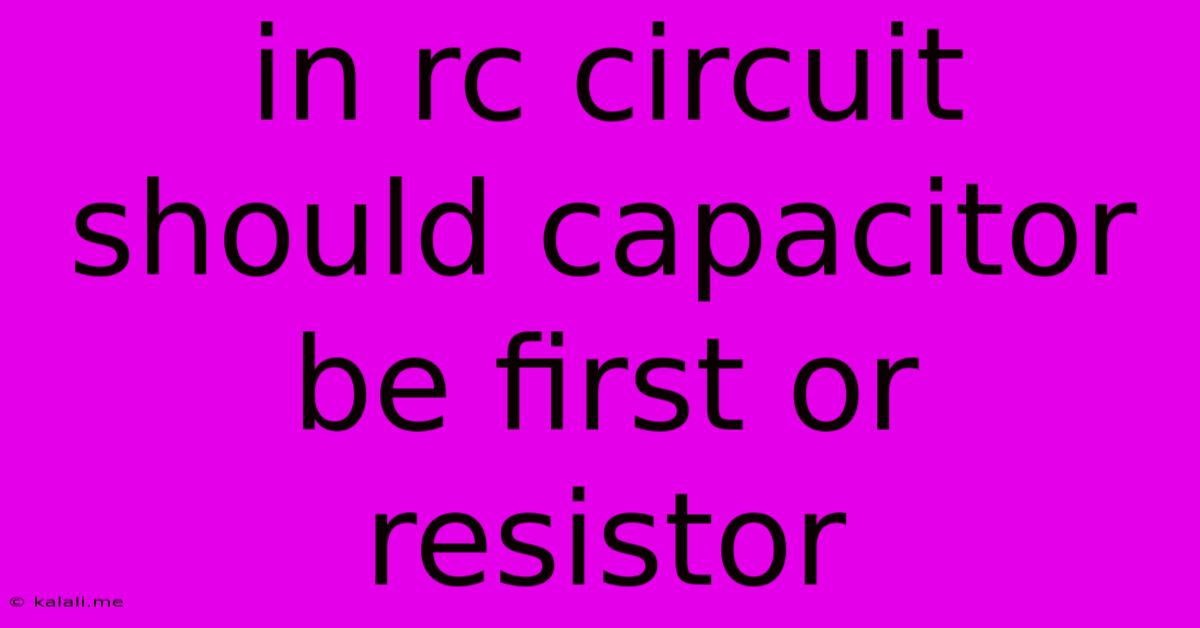In Rc Circuit Should Capacitor Be First Or Resistor
Kalali
May 23, 2025 · 3 min read

Table of Contents
RC Circuit: Capacitor First or Resistor First? Understanding the Implications
Meta Description: This article explores the seemingly simple question of capacitor vs. resistor placement in an RC circuit, delving into the implications for circuit behavior, time constants, and practical applications. Learn which configuration is appropriate for various scenarios.
The seemingly simple question of whether a capacitor should come before or after a resistor in an RC circuit actually holds significant implications for the circuit's behavior. While both configurations create a functioning RC circuit, the order affects the transient response, the voltage across components, and the overall application suitability. This article will clarify the differences and help you understand when to use each configuration.
Understanding RC Circuits and Time Constants
Before diving into the order of components, let's establish a basic understanding. An RC circuit, comprising a resistor (R) and a capacitor (C) connected in series or parallel, is fundamental in electronics. Its key characteristic is the time constant (τ), which determines how quickly the capacitor charges or discharges. The time constant is calculated as τ = R * C. A larger time constant indicates a slower charging/discharging process.
Capacitor First: The Charging/Discharging Implications
When the capacitor is placed first in the series RC circuit, the resistor follows. In this configuration:
-
Charging: The capacitor initially acts as a short circuit, allowing a large initial current to flow. As the capacitor charges, the current gradually decreases, leading to an exponential rise in voltage across the capacitor. The voltage across the resistor mirrors this, decreasing exponentially.
-
Discharging: The capacitor discharges through the resistor. The voltage across the capacitor decays exponentially, and the voltage across the resistor follows the same pattern but with opposite polarity.
This configuration is often used in applications where a controlled charging or discharging is required, such as:
- Simple timing circuits: Where the charging time is crucial for triggering an event.
- Filtering high-frequency noise: The capacitor acts as a bypass, shunting high-frequency signals to ground, while allowing lower frequencies to pass through the resistor.
- Camera flashes: Controlling the charging and discharging of the capacitor for the flash.
Resistor First: A Different Perspective
Placing the resistor first in a series RC circuit alters the transient behavior. Here's what happens:
-
Charging: The resistor limits the initial current, resulting in a slower initial charging rate compared to the capacitor-first configuration. The voltage across the capacitor rises exponentially, but at a slower pace.
-
Discharging: The discharge is also slower due to the resistor's current-limiting effect. The voltage across the capacitor still decays exponentially but at a more gradual rate.
This configuration might be preferred in applications where a gentle charging or discharging is needed, or where current limiting is a primary concern.
Parallel RC Circuits: A Different Dynamic
The discussion above primarily focuses on series RC circuits. In parallel RC circuits, the order of the components becomes irrelevant because the current splits between the resistor and capacitor simultaneously. The time constant remains the same, but the voltage across each component will be different. The capacitor will charge (or discharge) more quickly in a parallel configuration.
Conclusion: Choosing the Right Configuration
The "best" configuration—capacitor first or resistor first—depends entirely on the specific application requirements. Consider the desired charging/discharging rate, current limitations, and the overall functionality of the circuit. Understanding the impact of component order on the transient response is crucial for designing and troubleshooting RC circuits effectively. Remember to always consider the capacitance value and resistance value when determining the appropriate time constant for your application.
Latest Posts
Latest Posts
-
How Many Grams Of Sugar In A Pound
Jul 12, 2025
-
7am To 11am Is How Many Hours
Jul 12, 2025
-
If Your 35 What Year Was You Born
Jul 12, 2025
-
How Many Cups Is 1 Pound Of Cheese
Jul 12, 2025
-
30 X 30 Is How Many Square Feet
Jul 12, 2025
Related Post
Thank you for visiting our website which covers about In Rc Circuit Should Capacitor Be First Or Resistor . We hope the information provided has been useful to you. Feel free to contact us if you have any questions or need further assistance. See you next time and don't miss to bookmark.